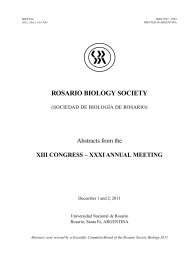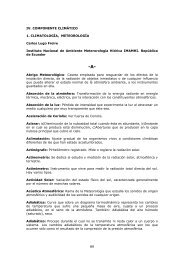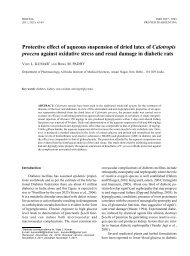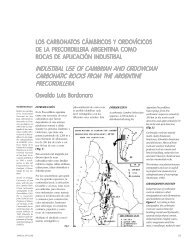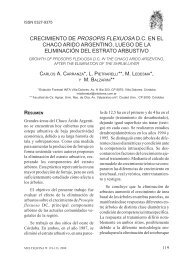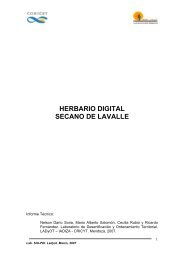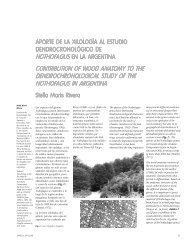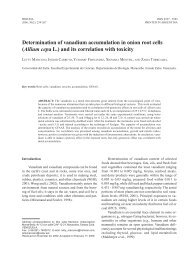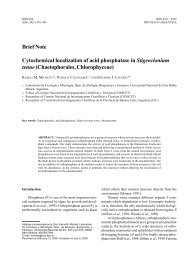XXII Annual Scientific Meeting, Tucuman Biology Society ...
XXII Annual Scientific Meeting, Tucuman Biology Society ...
XXII Annual Scientific Meeting, Tucuman Biology Society ...
You also want an ePaper? Increase the reach of your titles
YUMPU automatically turns print PDFs into web optimized ePapers that Google loves.
180 ABSTRACTS<br />
57.<br />
EFICACY OF INSECTICIDES FOLIAR IN CONTROL THE<br />
APHIS GOSSYPII GLOVER IN COTTON, SANTIAGO DEL<br />
ESTERO<br />
Beltran RE, Helman SA, Garay F, Lescano J.<br />
UNSE , FA y A, Av. Belgrano (s) 1912, 4200- Santiago del Estero.<br />
E-mail: rbeltran@unse.edu.ar<br />
The aphids were present along the entire cotton crop, but the highest<br />
populations were observed at the emergence of the first square<br />
at the end of effective flowering. In this stage the efficiency and<br />
residual of different foliar insecticides were evaluated in controlling<br />
the Aphis gossypii in cotton crops. The trials were conducted<br />
during the agricultural season 2002-03 and 2003-04 in the experimental<br />
field of La Maria (EEA Santiago del Estero). The design<br />
was block at random with 4 repetitions and the following active<br />
principles: Thiametoxan GW 25, oxidemeton metil CE. 25,<br />
oxidemeton metil CE. 25, Clorpirifos CE.48, Dimetoato CE 50 and<br />
untreated control. Four samplings was determined one previous to<br />
the applications and the rest to two, seven and twenty days later to<br />
applications. The counts of the aphids by leaf were in made in the<br />
fifth leaf of the main stem situated from the apex. The treatments<br />
began with an average density of 40-120 aphids/leaf with a uniform<br />
distribution in the test area.The results show to a significant<br />
difference between the untreated control and the different evaluated<br />
active principles. The Thiometoxam and metil Oxidemeton<br />
applied to the foliage significantly reduce to the population of aphids<br />
in the crop until the twenty days later to the treatments, providing<br />
levels of control over 70%.<br />
58.<br />
DETECTION AND PREVALENCE OF BACTERIAL<br />
VAGINOSIS IN FERTILE WOMEN<br />
Santos V 2 , Cangemi R 1 , Cecilia M 1 .<br />
Inst 1 Microb y de 2 Biol, Fac. de Bqca, Qca, Fcia. UNT. Chacabuco<br />
467. Tucumán.<br />
Bacterial vaginosis (BV) is one of the most frequent reasons of<br />
consultation by fertile and pregnant women. The normally lactobacilli<br />
are replaced by a polymicrobial flora with abundant short<br />
and curved bacilli, usually Gram-negative or variable (Gardnerella,<br />
Mobiluncus and anaerobic morphology). One hundred sexually<br />
active women, aged between 15 and 66 and treated at the Maternity<br />
in Tucumán, Argentina, were examined (35 of them were pregnant).<br />
From each patient samples were taken (cervix), carrying out<br />
a microscopy study. Gram staining was applied to study bacterial<br />
morphology using the Nugent scale, based on a semi-quantitative<br />
microscopy analysis of the vaginal flora, and Giemsa staining and<br />
a PAP test. In 96% of the cases fewer than 7 PMN per microscopic<br />
field were observed. Prevalence of BV was 23% and an intermediate<br />
stage was observed in 37%. 30% of the women under study<br />
were between 21 and 30 years of age, 26% between 31 and 40,<br />
22% between 41 and 50 and 22% under 20, 37% of the patients<br />
manifesting the disease were pregnant. Analyzing associations with<br />
BV Trichomonas vaginalis was found in 17% and yeast in 9%.<br />
Only in 2 pregnant patients without BV coilocyte and virocyte type<br />
cells were detected. The typical microscopy findings allow differentiation<br />
between normal and infectious secretions. Detection of<br />
coilocytes and virocytes is important, because they predict the presence<br />
of Papilloma virus.<br />
BIOCELL 30(1), 2006<br />
59.<br />
METABOLIC SYNDROME IN CHILDREN AND ADOLES-<br />
CENT POPULATION<br />
Bazán MC, Chaila MZ, Fabio S, Grassino F, Quiroga E, Simesen<br />
de Bielke H.<br />
Paediatric Department. UNT. Pje Hungría 750, San Miguel de<br />
Tucumán (CP:4000). E-mail: zchaila@arnet.com.ar<br />
Introduction: The overweight in children and adolescents is associated<br />
to metabolic alterations known as metabolic syndrome (MS).<br />
It is related to a significant increase of diabetes type 2 (DT2) and<br />
cardiovascular disease (CVD) risk.<br />
Objective: to determine risk factors (RF) for MS in children and<br />
adolescents in scholar population.<br />
Materials and methods: 157 students aged 11-16 yr were evaluated.<br />
Parameters of weight (W), height (H), waist circumference<br />
(WC), Blood Pressure (BP) and Body Mass Index (BMI) were determined<br />
in all subjects. After known the presence of one or more<br />
RF, the study was completed with the biochemical analyses and<br />
the nutritional survey.<br />
Results: from the 157 evaluated students, 25,5% have one or more<br />
RF for MS. 17,8% have overweight, 5,7% obesity, 10,2% with WC<br />
>90 percentile, 5,1% with high BP, and 3,2% have lipids profile<br />
alterations. One student presents Glucose greater than 110 mg/dl<br />
(0,6%), and 7 students have high HOMA Index (4,5%). This indicates<br />
Insulin Resistance Syndrome. From the 14 subjects tested in<br />
the laboratory, 7 present 3 or more RF for MS (4,5%).<br />
Conclusions: we suggest the importance of the valuation in children<br />
and adolescents of the RF that constitute the MS to prevent<br />
the complications like DT2 and CVD.<br />
60.<br />
TAXONOMIC STATUS OF JENYNSIA CF. ALTERNIMACULATA<br />
(CYPRINODONTIFORMES: ANABLEPIDAE) FROM THE RÍO<br />
ARENALES BASIN, SALTA, ARGENTINA<br />
Aguilera G., Mirande JM.<br />
CONICET-Fundación Miguel Lillo, Miguel Lillo 251, San Miguel<br />
de Tucumán (CP. 4000), Tucumán, Argentina.<br />
E-mail: gastonaguilera@hotmail.com<br />
The family Anablepidae is composed by 3 genera. Among them,<br />
Jenynsia, is the most diverse. Ghedotti (1998) analyze the phylogenetic<br />
relation-ships of the family. In Salta, Argentina, two species<br />
of Jenynsia are present, J. maculata and J. alternimaculata.<br />
The latter is very similar to the specimens found in Río Arenales.<br />
As the type locality of Jenynsia alternimaculata is in the Río<br />
Bermejo Basin and the Río Arenales do not belong to it, the taxonomic<br />
status of the specimens of the latter river is tested in this<br />
work. A re-analysis of the Ghedotti’s (1998) matrix was performed<br />
with TNT, by using implicit enumeration under equal and implied<br />
weighting. The specimens from Río Arenales are separated in all<br />
the analysis from J. alternimaculata, possibly conforming two different<br />
species.



